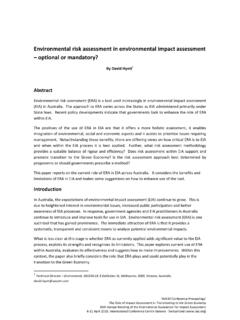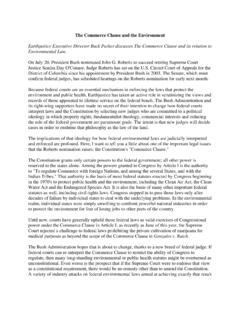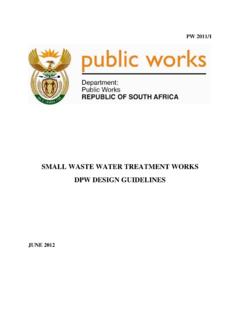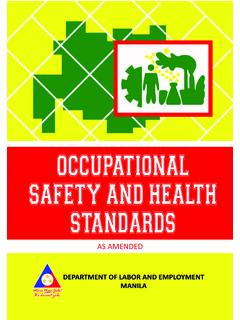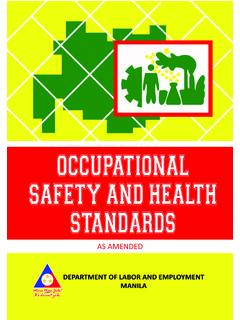Transcription of The role of Environmental Impact Assessment for ...
1 The role of Environmental Impact Assessment for sustainable development Asnake Mekuriaw1,2 and Belay Teffera1. 1. Bahir Dar University, Bahir Dar, Ethiopia 2. Center for Development and Environment, University of Bern, Bern, Switzerland Abstract An Environmental Impact Assessment (EIA) study was conducted in Ethiopia to assess the Environmental and social impacts of a planned floriculture project. The aim of the project was to grow and export good quality flowers. The proposed site is located about 16 km from Bahir Dar city, Amhara region, Ethiopia. The study was conducted in three-phases. In phase one the existing project documents and different proclamations, regulations and conventions related to EIA were assessed.
2 In the second phase biophysical and socio-economic data was collected from the proposed project area and its surrounding. In addition the opinion of the wider community and the stakeholders was gathered through discussion. In the third phase, the data were analyzed using quantitative and qualitative techniques and interpreted based on available standards and legal requirements. The study showed that the project has a number of potentially positive impacts such as, high income tax, job opportunities, introduction of modern technology, etc. However, there are potentially negative impacts including, water resource depletion, water pollution, soil degradation, human health problems, emergence of new pests and improper waste disposal.
3 Water resource depletion was found to be the most serious problem as the flower farm requires high amounts of water and the ground water potential of the surrounding area is below the required amount. The local community uses the surface and ground water for small scale irrigation and for their cattle, resulting in potential conflicts. The EIA study suggested that an alternative site should be identified to implement the project at full scale or reduce its size so as to make the project sustainable at the proposed site. Key words: EIA, planned floriculture project, potential impacts, sustainable development 1. Introduction Environmental concern has become one of the major global issue that affects all nations individually and/or collectively (Garg 2006).
4 Cognizant of this the Ethiopian government has set Environmental policies, laws and regulations, and administrative frameworks requiring Environmental Assessment prior to the launching of any investment and development activity in the country (EPA 2012). The government of Ethiopia has also set up a regulatory body - the Environmental protection Authority (EPA) of Ethiopia. This agency is mandated to predict and manage the Environmental impacts that may be caused by any investment activity as a result of its construction, operations, or an ongoing modification or termination, and thereby helps to promote the proposed development. In Ethiopia, agriculture is the backbone of the country's economy and the foundation for the economic welfare of the population.
5 The current government of the country has given special emphasis to the contribution of private investment in agricultural development such as in modern flower farm, crop production, and fruit and vegetables productions which have a significant ripple effect throughout the economy. Proclamation No. 280/2002 (Re-Enactment of the 'IAIA13 Conference Proceedings'. Impact Assessment the Next Generation 33rd Annual Meeting of the International Association for Impact Assessment 13 16 May 2013, Calgary Stampede BMO Centre | Calgary, Alberta, Canada ( ). Investment Proclamation), and Council of Ministers Regulations No. 84/2003 encourage both local and foreign investors to actively participate in this strategy.
6 The rapidly increasing demand in developed countries has made flowers the best of exportable commodities. Ethiopia has fairly constant climate that allows farming throughout the entire year. In addition, its accessibility to the European, Asian and Middle East markets, gives the country a huge potential to supply high quality flowers to the world. Cognizant of these advantages, several investors are committed to engage in the sector and to produce highest quality cut flowers for domestic and export market. In the past, development endeavors have not considered Environmental issues in the evaluation of development projects. Decision-making about implementation of development projects was merely focused on short-term technical feasibility and economic benefits.
7 This negligence and unwise utilization of the natural resources resulted in degradation of the environment and scarcity of the resources (Adohinzin et al. 2010, Joshi et , Garg 2006, Katyal 2001). The trend toward natural resource and Environmental degradation stimulated the concept of sustainable development. According to the World Commission of the Environment and Development (1987) sustainable development is defined as development that meets the needs of the present without compromising the ability of future generations to meet their own needs. It encompasses three pillars namely: economy, environment and society. The social pillar refers to meeting the basic needs of society, the economic component refers to efficiently managing the economy to meet material needs and the Environmental component is concerned with the conservation and enhancement of the physical and biological resource base and ecosystems (UN.)
8 DESA 2002). An Assessment of potential impacts on the environment prior to the approval of investment proposals provides a means of harmonizing and integrating the three pillars of sustainable development. Thus EIA, which is the process of identifying, predicting, evaluating and mitigating the biophysical, social, and other relevant effects of development proposals prior to major decisions being taken and commitments made (wood 2003, IAIA 1999), has become one of the preconditions for permitting investment projects prior to implementation. Therefore this paper aims to show the importance of EIA for sustainable development. 2. Policy, Legal and Administrative framework The Ethiopian government attempts to integrate Environmental concerns in its Development Strategies so as to address sustainable livelihoods of the population within the context of sound Environmental management considerations in decision making and project planning (EPA 2012, EPA 2003).
9 To this end it is pertinent to mention the relevant policies and constitutional support in undertaking EIA in Ethiopia. Constitutional support The constitution of Ethiopia contains a number of articles, pertinent to Environmental issues concerning development projects. The concept of sustainable development and Environmental rights are enshrined in Article 43(the Right to Development), Article 44(Environment Rights). and Article 92( Environmental Objective) of the constitution of Ethiopia. 2. Environmental Policy of Ethiopia The government of Ethiopia formulated and approved the Environmental policy of the country in 1997 (EPA 2012). The key objective of the policy is to update and suggest corrective measures to remove deficiencies of the previous policies for the Environmental protection and conservation.
10 The thrust of Environmental policy in Ethiopia is to achieve sustainable development in agriculture, water resources, and industrial and infrastructure sectors and as a result improve and enhance the quality of life of its citizens. One of the principles that has been relatively easy to agree upon is Environmental policy integration, which is the integration of Environmental aspects and policy objectives into sector policies (Persson 2004). The policy contains several sectoral and cross-sectoral policies and various guidelines for its implementations. 3. Materials and methods Project site The proposed project site, Meshenti, is located about 16 kms from Bahir Dar city, Ethiopia. It covers a total area of 425 hectares.
